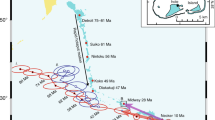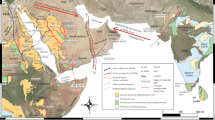Abstract
The central Indian Ocean is considered the archetypal diffuse oceanic plate boundary. Data from seismic stratigraphy and deep-sea drilling indicate that the contractional deformation of the Indian Ocean lithosphere commenced at 15.4–13.9 Ma, but experienced a sharp increase at 8–7.5 Ma. This has been maintained through to the present day, with over 80% of the shortening accrued over the past 8 Myr. Here we build on previous efforts to refine the form, timing and magnitude of the regional plate-motion changes by mitigating the noise in reconstructed Indian and Capricorn plate motions relative to Somalia. Our noise-mitigated reconstructions tightly constrain the significant speed up of the Capricorn plate over the past 8 Myr and demonstrate that the history of the Indian Ocean floor deformation cannot be explained without this plate-motion change. We propose that the Capricorn plate-motion change is driven by an increase in the eastward-directed asthenospheric flow associated with the adjacent Reunion plume, and quantitatively demonstrate the viability of this hypothesis. Our inference is supported by volcanic age distributions along the Reunion hotspot track, the anomalously high residual bathymetry of the Central Indian Ridge, full-waveform seismic tomography of the underlying asthenosphere and geochemical observations from the Central Indian Ridge. These findings challenge the commonly accepted link between the deformation of the Indian Ocean floor and the Tibetan Plateau’s orogenic evolution and demonstrate that temporal variations in upwelling mantle flow can drive major tectonic events at the Earth’s surface.
This is a preview of subscription content, access via your institution
Access options
Access Nature and 54 other Nature Portfolio journals
Get Nature+, our best-value online-access subscription
$29.99 / 30 days
cancel any time
Subscribe to this journal
Receive 12 print issues and online access
$259.00 per year
only $21.58 per issue
Buy this article
- Purchase on Springer Link
- Instant access to full article PDF
Prices may be subject to local taxes which are calculated during checkout




Similar content being viewed by others
References
Stein, S. & Okal, E. A. Seismicity and tectonics of the Ninetyeast Ridge area: evidence for internal deformation of the Indian plate. J. Geophys. Res. 83, 2233–2245 (1978).
Bull, J. M. & Scrutton, R. A. Seismic reflection images of intraplate deformation, central Indian Ocean, and their tectonic significance. J. Geol. Soc. Lond. 149, 955–966 (1992).
Krishna, K. S. et al. Periodic deformation of oceanic crust in the central Indian Ocean. J. Geophys. Res. 103, 17859–17875 (1998).
Curray, J. R., Emmel, F. J. & Moore, D. G. The Bengal Fan: morphology, geometry, stratigraphy, history and processes. Mar. Pet. Geol. 19, 1191–1223 (2002).
Wiens, D. A. et al. A diffuse plate boundary model for Indian Ocean tectonics. Geophys. Res. Lett. 12, 429–432 (1985).
Gordon, R. G., Stein, S., DeMets, C. & Argus, D. F. Statistical tests for closure of plate motion circuits. Geophys. Res. Lett. 14, 587–590 (1987).
Royer, J. Y. & Chang, T. Evidence for relative motions between the Indian and Australian plates during the last 20 m.y. from plate tectonic reconstructions: implications for the deformation of the Indo–Australian plate. J. Geophys. Res. 96, 11779–11802 (1991).
DeMets, C., Gordon, R. G. & Vogt, P. Location of the Africa–Australia–India triple junction and motion between the Australian and Indian plates: results from an aeromagnetic investigation of the Central Indian and Carlsberg ridges. Geophys. J. Int. 119, 893–930 (1994).
Royer, J. Y. & Gordon, R. G. The motion and boundary between the Capricorn and Australian plates. Science 277, 1268–1274 (1997).
Gordon, R. G. The plate tectonic approximation: plate nonrigidity, diffuse plate boundaries, and global plate reconstructions. Annu. Rev. Earth Planet. Sci. 26, 615–642 (1998).
Zatman, S., Gordon, R. G. & Richards, M. A. Analytic models for the dynamics of diffuse oceanic plate boundaries. Geophys. J. Int. 145, 145–156 (2001).
Gordon, R. G., DeMets, C. & Royer, J. Y. Evidence for long-term diffuse deformation of the lithosphere of the equatorial Indian Ocean. Nature 395, 370–374 (1998).
DeMets, C., Gordon, R. G. & Royer, J.-Y. Motion between the Indian, Capricorn and Somalian plates since 20 Ma: implications for the timing and magnitude of distributed lithospheric deformation in the equatorial Indian Ocean. Geophys. J. Int. 161, 445–468 (2005).
Krishna, K. S., Bull, J. M. & Scrutton, R. A. Early (pre-8 Ma) fault activity and temporal strain accumulation in the central Indian Ocean. Geology 37, 227–230 (2009).
Bull, J. M., DeMets, C., Krishna, K. S., Sanderson, D. J. & Merkouriev, S. Reconciling plate kinematic and seismic estimates of lithospheric convergence in the central Indian Ocean. Geology 38, 307–310 (2010).
Molnar, P., England, P. & Martinod, J. Mantle dynamics, uplift of the Tibetan plateau, and the Indian monsoon. Rev. Geophys. 31, 357–396 (1993).
Weissel, J. K., Anderson, R. N. & Geller, C. A. Deformation of the Indo–Australian plate. Nature 287, 284–291 (1980).
Iaffaldano, G., Bunge, H.-P. & Dixon, T. H. Feedback between mountain belt growth and plate convergence. Geology 34, 893–896 (2006).
Copley, A., Avouac, J.-P. & Royer, J.-Y. India–Asia collision and the Cenozoic slowdown of the Indian plate: implications for the forces driving plate motions. J. Geophys. Res. 115, B03410 (2010).
Molnar, P. & Stock, J. M. Slowing of India’s convergence with Eurasia since 20 Ma and its implications for Tibetan mantle dynamics. Tectonics 28, TC3001 (2009).
Rowley, D. B. & Currie, B. S. Palaeo-altimetry of the late Eocene to Miocene Lunpola basin, central Tibet. Nature 439, 677–681 (2006).
Priestley, K., Jackson, J. & McKenzie, D. Lithospheric structure and deep earthquakes beneath India, the Himalaya and southern Tibet. Geophys. J. Int. 172, 345–362 (2008).
Merkouriev, S. & DeMets, C. Constraints on Indian plate motion since 20 Ma from dense Russian magnetic data: implications for Indian plate dynamics. Geochem. Geophys. Geosystems 7, Q02002 (2006).
Iaffaldano, G., Bodin, T. & Sambridge, M. Slow-downs and speed-ups of India–Eurasia convergence since ~20 Ma: data-noise, uncertainties and dynamic implications. Earth Planet. Sci. Lett. 367, 146–156 (2013).
Iaffaldano, G., Bodin, T. & Sambridge, M. Reconstructing plate-motion changes in the presence of finite-rotations noise. Nat. Commun. 3, 1048 (2012).
Iaffaldano, G., Hawkins, R., Bodin, T. & Sambridge, M. REDBACK: open-source software for efficient noise-reduction in plate kinematic reconstructions. Geochem. Geophys. Geosystems 15, 1663–1670 (2014).
Torsvik, T. H., Steinberger, B., Gurnis, M. & Gaina, C. Plate tectonics and net lithosphere rotation over the past 150 My. Earth Planet. Sci. Lett. 291, 106–112 (2010).
Iaffaldano, G. & DeMets, C. Late Neogene changes in North America and Antarctica absolute plate motions inferred from the Mid-Atlantic and Southwest Indian Ridges spreading histories. Geophys. Res. Lett. 43, 8466–8472 (2016).
Harrison, T. M., Copenald, P., Kidd, W. S. F. & Yin, A. Raising Tibet. Science 255, 1663–1670 (1992).
Hoeink, T. & Lenardic, A. Three-dimensional mantle convection simulations with a low-viscosity asthenosphere and the relationship between heat flow and the horizontal length scale of convection. Geophys. Res. Lett. 35, L10304 (2008).
Hoeink, T. & Lenardic, A. Long wavelength convection, Poiseuille–Couette flow in the low-viscosity asthenosphere and the strength of plate margins. Geophys. J. Int. 180, 23–33 (2010).
Natarov, S. I. & Conrad, C. P. The role of Poiseuille flow in creating depth-variation of asthenospheric shear. Geophys. J. Int. 190, 1297–1310 (2012).
Duncan, R. & Richards, M. Hotspots, mantle plumes, flood basalts, and true polar wander. Rev. Geophys. 29, 31–50 (1991).
Duncan, R. & Storey, M. in The Life Cycle of Indian Ocean Hotspots, Vol. 29 (eds Duncan, R. A. et al.) 91–103 (American Geophysical Union, Washington, DC, 1992).
Morgan, W. J. Rodriguez, Darwin, Amsterdam, …, a second type of hotspot island. J. Geophys. Res. 83, 5355–5360 (1978).
Torsvik, T. H. et al. A Precambrian microcontinent in the Indian Ocean. Nat. Geosci. 6, 223–227 (2013).
French, S., Lekic, V. & Romanowicz, B. Waveform tomography reveals channeled flow at the base of the oceanic asthenosphere. Science 342, 227–230 (2013).
Murton, B. M., Tindle, A. E., Milton, J. A. & Sauter, D. Heterogeneity in southern central Indian ridge MORB: implications for ridge–hot spot interaction. Geochem. Geophys. Geosystems 6, Q03E20 (2005).
Paulson, A. & Richards, M. A. On the resolution of radial viscosity structure in modelling long-wavelength postglacial rebound data. Geophys. J. Int. 179, 1516–1526 (2009).
Iaffaldano, G. & Lambeck, K. Pacific plate-motion change at the time of the Hawaiian–Emperor bend constrains the viscosity of Earth’s asthenosphere. Geophys. Res. Lett. 41, 3398–3406 (2014).
Cande, S. C. & Stegman, D. R. Indian and African plate motions driven by the push force of the Reunion plume head. Nature 475, 47–52 (2011).
van Hinsbergen, D. J. J., Steinberger, B., Doubrovine, P. V. & Gassmöller, R. Acceleration and deceleration of India–Asia convergence since the Cretaceous: roles of mantle plumes and continental collision. J. Geophys. Res. 116, B06101 (2011).
Ballmer, M. D., Conrad, C. P., Smith, E. I. & Harmon, N. Non-hotspot volcano chains produced by migration of shear-driven upwelling toward the East Pacific Rise. Geology 41, 479–482 (2013).
Hawley, W. B., Allen, R. M. & Richards, M. A. Tomography reveals buoyant asthenosphere accumulating beneath the Juan de Fuca plate. Science 353, 1406–1408 (2016).
Stotz, I. L., Iaffaldano, G. & Davies, D. R. Pressure-driven Poiseuille flow: a major component of the torque-balance governing Pacific plate motion. Geophys. Res. Lett. 45, 117–125(2018).
Sleep, N. H. Hotspots and mantle plumes: some phenomenology. J. Geophys. Res. 95, 6715–6736 (1990).
Malinverno, A. & Briggs, V. A. Expanded uncertainty quantification in inverse problems: hierarchical Bayes and empirical Bayes. Geophysics 69, 1005–1016 (2004).
Sambridge, M., Gallagher, K., Jackson, A. & Rickwood, P. Trans-dimensional inverse problems, model comparison and the evidence. Geophys. J. Int. 167, 528–542 (2006).
Smith, W. H. F. & Sandwell, D. T. Global sea floor topography from satellite altimetry and ship depth soundings. Science 277, 1956–1962 (1997).
Gibbons, A. D., Zahirovic, S., Muller, R. D., Whittaker, J. M. & Yatheesh, V. A tectonic model reconciling evidence for the collisions between India, Eurasia and intra-oceanic arcs of the central–eastern Tethys. Gondwana Res. 28, 451–492 (2015).
Stein, C. A. & Stein, S. A model for the global variation in oceanic depth and heat flow with lithospheric age. Nature 359, 123–129 (1992).
Chapple, W. M. & Tullis, T. E. Evaluation of the forces that drive the plates. J. Geophys. Res. 82, 1967–1984 (1977).
Iaffaldano, G. & Bunge, H.-P. Rapid plate motion variations: observations serving geodynamic interpretation. Annu. Rev. Earth Planet. Sci. 43, 571–592 (2015).
Turcotte, D. & Schubert, G. Geodynamics (Cambridge Univ. Press, Cambridge, 2002).
Watts, A. B. Isostasy and Flexure of the Lithosphere (Cambridge Univ. Press, Cambridge, 2001).
Acknowledgements
G.I. acknowledges support from the Department of Geosciences and Natural Resource Management at the University of Copenhagen. D.R.D. acknowledges support from the Australian Research Council, under grant nos FT140101262 and DP170100058. The authors are grateful to R. Gordon and A. Whitchurch for constructive comments that improved this study.
Author information
Authors and Affiliations
Contributions
G.I. conceived the study. G.I. and C.D. undertook the noise-mitigation analysis. G.I. performed the calculations of lithosphere shortening, residual bathymetry and torque changes. D.R.D. undertook the analysis of volcanism along the Reunion hotspot track and tied in associated interdisciplinary observational constraints. All the authors contributed to discussing and writing the paper.
Corresponding author
Ethics declarations
Competing interests
The authors declare no competing interests.
Additional information
Publisher’s note: Springer Nature remains neutral with regard to jurisdictional claims in published maps and institutional affiliations.
Supplementary information
Supplementary Information
Supplementary Figures and Supplementary Tables
Rights and permissions
About this article
Cite this article
Iaffaldano, G., Davies, D.R. & DeMets, C. Indian Ocean floor deformation induced by the Reunion plume rather than the Tibetan Plateau. Nature Geosci 11, 362–366 (2018). https://doi.org/10.1038/s41561-018-0110-z
Received:
Accepted:
Published:
Issue Date:
DOI: https://doi.org/10.1038/s41561-018-0110-z
This article is cited by
-
Large-scale flow of Indian Ocean asthenosphere driven by Réunion plume
Nature Geoscience (2019)



